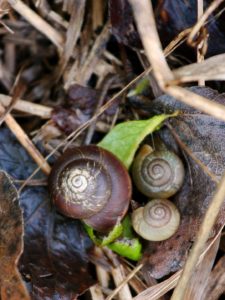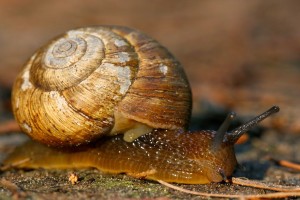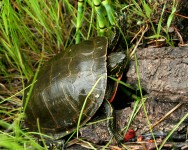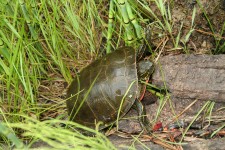There in the grass were big snail shells, medium snail shells and itty bitty snails in tiny shells. I’d only ever seen big snail shells until I stumbled upon a spot in the woods where there were all sizes. I knew snail shells grew with the snail but had never seen small ones before.

Many species of animals utilize shells for protection and a place to live. Snails, turtles, clams, crabs, oyster and scallops all grow lightweight, hollow shells. However, they’re not all created the same.
When a crab outgrows its shell, it can grow another one. A hermit crab will discard its shell and find a new one.
Turtles and snails, on the other hand, enlarge their shells as they grow but they are not created the same way. A turtle’s shell is part of its endoskeleton–a skeleton within the body. A snail’s shell is its exoskeleton–a skeleton on the outside of the body.
Turtle shells
Since a turtle’s shell is part of its endoskeleton, it contains nerves, blood vessels and living cells. Bone cells on the surface secrete protein and minerals to grow, reshape and repair damage. Blood vessels supply protein and calcium to the bone cells.

The scutes on the shell’s surface are epidermal structures, like our fingernails, composed of the protein keratin. The shell is formed by the carapace (top part) and the plastron (bottom part) that join on the sides to create a rigid skeleton box. During development certain vertebrae and ribs fuse together to make the carapace. Large plates of dermal bone create the plastron.
The bone within a turtle shell is composed of 33 percent protein and 66 percent hydroxyapatite, a mineral largely composed of calcium phosphate. Interestingly, turtle shells are composed of calcium phosphate while snail shells are composed of calcium carbonate. Both forms of calcium create strong protective shells that don’t dissolve in water.
Snail shells
Snails are born with a protoconch (first shell) that is soft and colorless. Newly hatched snails need calcium in their diet to help harden the shell and they often eat the egg from which they hatched.

Snail shells grow in a spiral pattern around a central axis called the columella. The opening where the snail goes into its shell is called the aperture. The aperture is where new growth is added to the shell.
A snail shell is composed of three layers. The outer layer is the periostracum and is made of conchiolin (a mixture of proteins and chitin). The middle layer is a prismatic calcified layer made of calcium carbonate. The inner layer is an iridescent pearly layer (nacre) made of crystal aragonite platelets.
To create the shell, mantle tissue (body tissue in contact with the shell) secretes the proteins and minerals needed for each layer and begins with the outer layer. The shell grows with the snail and isn’t shed like the exoskeleton of some insects.
Interestingly, snail shells contain two forms of calcium carbonate (CaCO3) arranged differently: calcite and aragonite. The calcite is the same material stalactites and stalagmites are made of in caves. The pearly nacre layer contains aragonite which geologically forms in high temperature and high pressure conditions and isn’t geologically stable at Earth’s surface. Scientists still don’t understand how snails and shellfish can create unstable aragonite to use within their shells.
Also a mystery is the mechanism within animals that oversees the creation of a shell. Did you know that snail shells predominantly rotate to the right? Although in the fossil record, left spirals are dominant during some time periods.
Whether endoskeleton or exoskeleton, the lightweight, durable homes of shelled animals hold many secrets.




